Analysis of Staff Turnover and HRM Practices at Hilton Hotel Sydney
VerifiedAdded on 2020/03/16
|10
|2836
|78
Report
AI Summary
This report investigates the increasing staff turnover rate at Hilton Hotel Sydney, recognizing its detrimental effects on operations and profitability. The research aims to identify the reasons behind this issue, focusing on the importance of effective human resource management practices in the hospitality industry. The literature review explores factors like staff training, employee retention strategies, and workplace conflicts. The proposed methodology includes an exploratory research design, data collection through secondary sources and expert interviews with ten managers using purposive sampling, and qualitative data analysis with thematic analysis. Ethical considerations and limitations, such as sample size and data access, are also addressed. The study seeks to provide recommendations for Hilton Hotel Sydney to reduce staff turnover and improve employee retention.
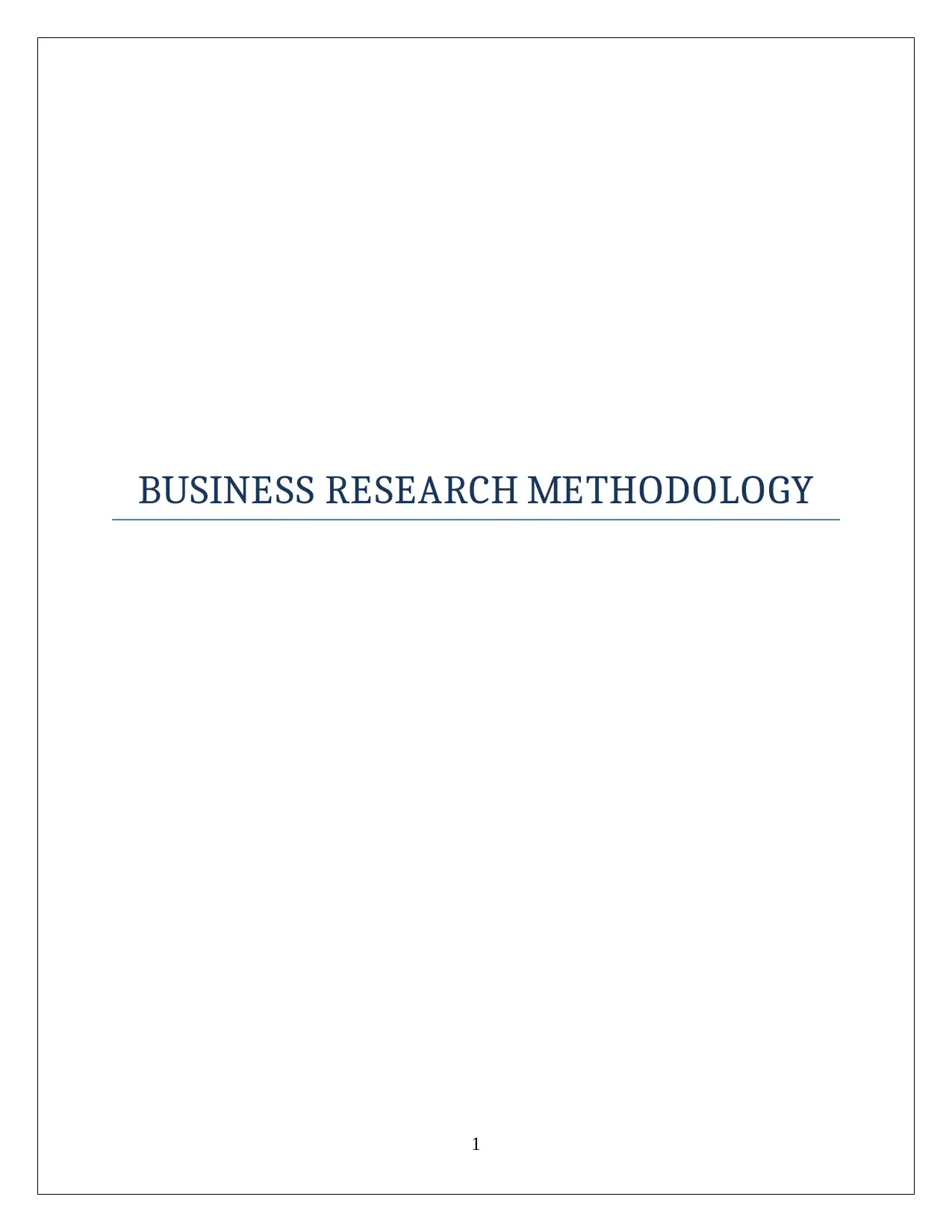
BUSINESS RESEARCH METHODOLOGY
1
1
Paraphrase This Document
Need a fresh take? Get an instant paraphrase of this document with our AI Paraphraser
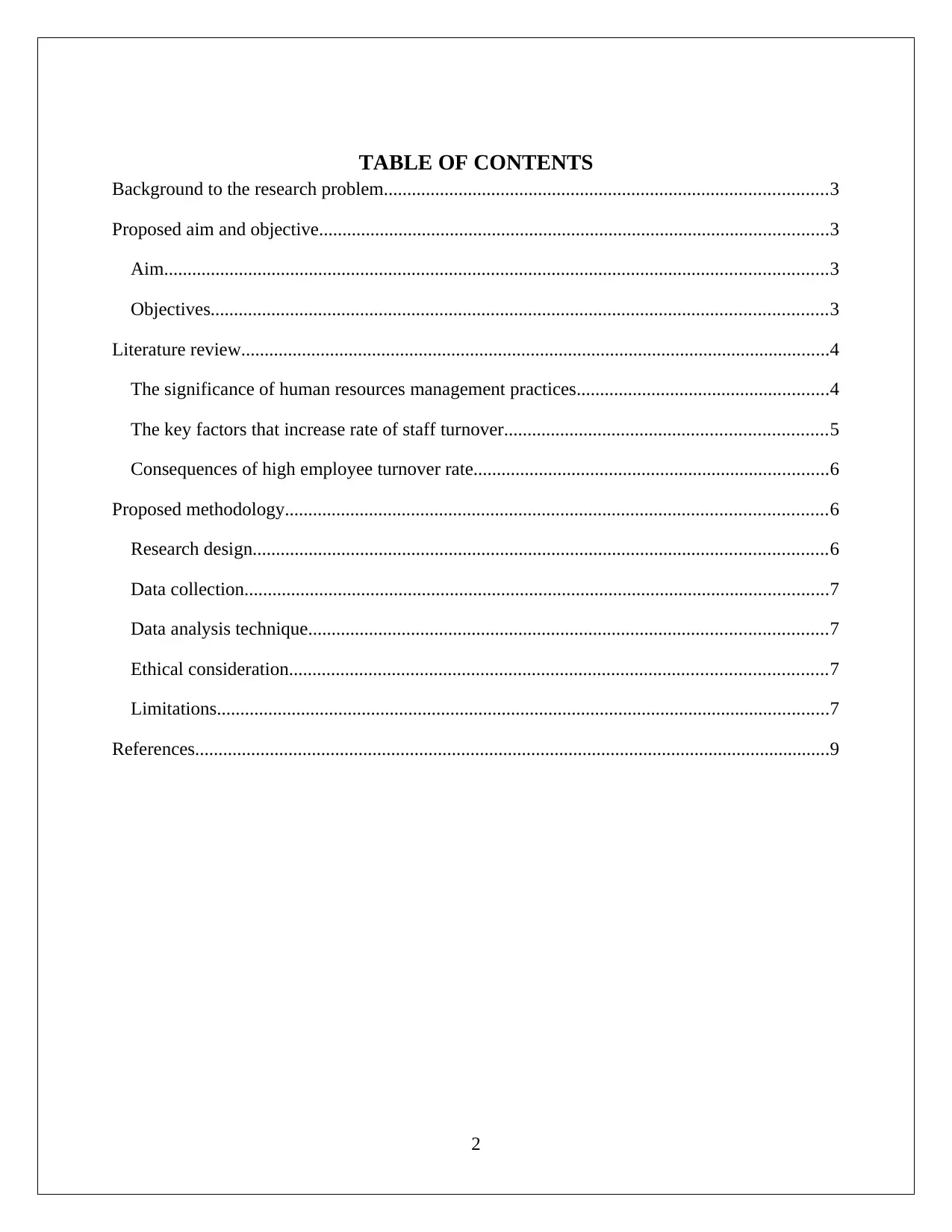
TABLE OF CONTENTS
Background to the research problem...............................................................................................3
Proposed aim and objective.............................................................................................................3
Aim..............................................................................................................................................3
Objectives....................................................................................................................................3
Literature review..............................................................................................................................4
The significance of human resources management practices......................................................4
The key factors that increase rate of staff turnover.....................................................................5
Consequences of high employee turnover rate............................................................................6
Proposed methodology....................................................................................................................6
Research design...........................................................................................................................6
Data collection.............................................................................................................................7
Data analysis technique...............................................................................................................7
Ethical consideration...................................................................................................................7
Limitations...................................................................................................................................7
References........................................................................................................................................9
2
Background to the research problem...............................................................................................3
Proposed aim and objective.............................................................................................................3
Aim..............................................................................................................................................3
Objectives....................................................................................................................................3
Literature review..............................................................................................................................4
The significance of human resources management practices......................................................4
The key factors that increase rate of staff turnover.....................................................................5
Consequences of high employee turnover rate............................................................................6
Proposed methodology....................................................................................................................6
Research design...........................................................................................................................6
Data collection.............................................................................................................................7
Data analysis technique...............................................................................................................7
Ethical consideration...................................................................................................................7
Limitations...................................................................................................................................7
References........................................................................................................................................9
2
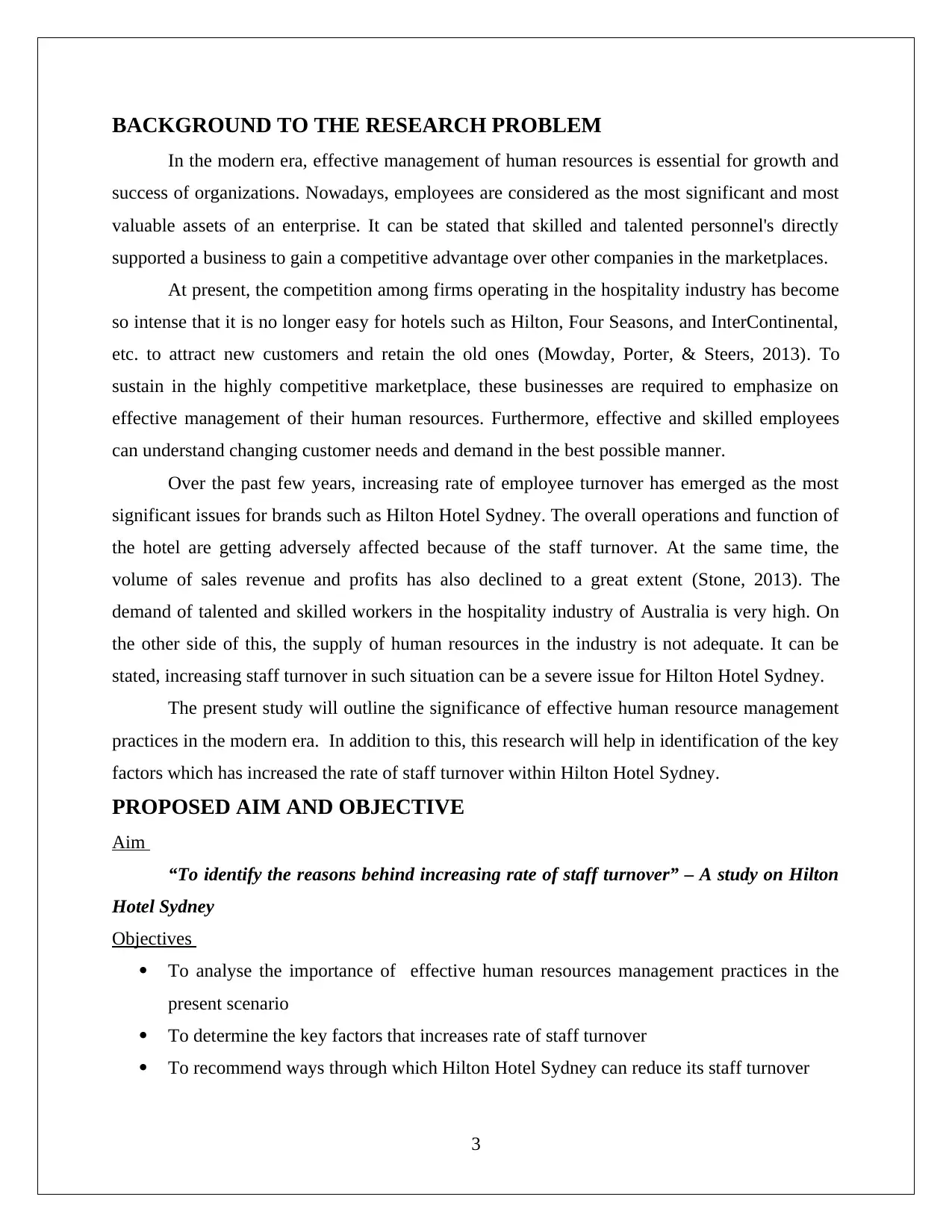
BACKGROUND TO THE RESEARCH PROBLEM
In the modern era, effective management of human resources is essential for growth and
success of organizations. Nowadays, employees are considered as the most significant and most
valuable assets of an enterprise. It can be stated that skilled and talented personnel's directly
supported a business to gain a competitive advantage over other companies in the marketplaces.
At present, the competition among firms operating in the hospitality industry has become
so intense that it is no longer easy for hotels such as Hilton, Four Seasons, and InterContinental,
etc. to attract new customers and retain the old ones (Mowday, Porter, & Steers, 2013). To
sustain in the highly competitive marketplace, these businesses are required to emphasize on
effective management of their human resources. Furthermore, effective and skilled employees
can understand changing customer needs and demand in the best possible manner.
Over the past few years, increasing rate of employee turnover has emerged as the most
significant issues for brands such as Hilton Hotel Sydney. The overall operations and function of
the hotel are getting adversely affected because of the staff turnover. At the same time, the
volume of sales revenue and profits has also declined to a great extent (Stone, 2013). The
demand of talented and skilled workers in the hospitality industry of Australia is very high. On
the other side of this, the supply of human resources in the industry is not adequate. It can be
stated, increasing staff turnover in such situation can be a severe issue for Hilton Hotel Sydney.
The present study will outline the significance of effective human resource management
practices in the modern era. In addition to this, this research will help in identification of the key
factors which has increased the rate of staff turnover within Hilton Hotel Sydney.
PROPOSED AIM AND OBJECTIVE
Aim
“To identify the reasons behind increasing rate of staff turnover” – A study on Hilton
Hotel Sydney
Objectives
To analyse the importance of effective human resources management practices in the
present scenario
To determine the key factors that increases rate of staff turnover
To recommend ways through which Hilton Hotel Sydney can reduce its staff turnover
3
In the modern era, effective management of human resources is essential for growth and
success of organizations. Nowadays, employees are considered as the most significant and most
valuable assets of an enterprise. It can be stated that skilled and talented personnel's directly
supported a business to gain a competitive advantage over other companies in the marketplaces.
At present, the competition among firms operating in the hospitality industry has become
so intense that it is no longer easy for hotels such as Hilton, Four Seasons, and InterContinental,
etc. to attract new customers and retain the old ones (Mowday, Porter, & Steers, 2013). To
sustain in the highly competitive marketplace, these businesses are required to emphasize on
effective management of their human resources. Furthermore, effective and skilled employees
can understand changing customer needs and demand in the best possible manner.
Over the past few years, increasing rate of employee turnover has emerged as the most
significant issues for brands such as Hilton Hotel Sydney. The overall operations and function of
the hotel are getting adversely affected because of the staff turnover. At the same time, the
volume of sales revenue and profits has also declined to a great extent (Stone, 2013). The
demand of talented and skilled workers in the hospitality industry of Australia is very high. On
the other side of this, the supply of human resources in the industry is not adequate. It can be
stated, increasing staff turnover in such situation can be a severe issue for Hilton Hotel Sydney.
The present study will outline the significance of effective human resource management
practices in the modern era. In addition to this, this research will help in identification of the key
factors which has increased the rate of staff turnover within Hilton Hotel Sydney.
PROPOSED AIM AND OBJECTIVE
Aim
“To identify the reasons behind increasing rate of staff turnover” – A study on Hilton
Hotel Sydney
Objectives
To analyse the importance of effective human resources management practices in the
present scenario
To determine the key factors that increases rate of staff turnover
To recommend ways through which Hilton Hotel Sydney can reduce its staff turnover
3
⊘ This is a preview!⊘
Do you want full access?
Subscribe today to unlock all pages.

Trusted by 1+ million students worldwide
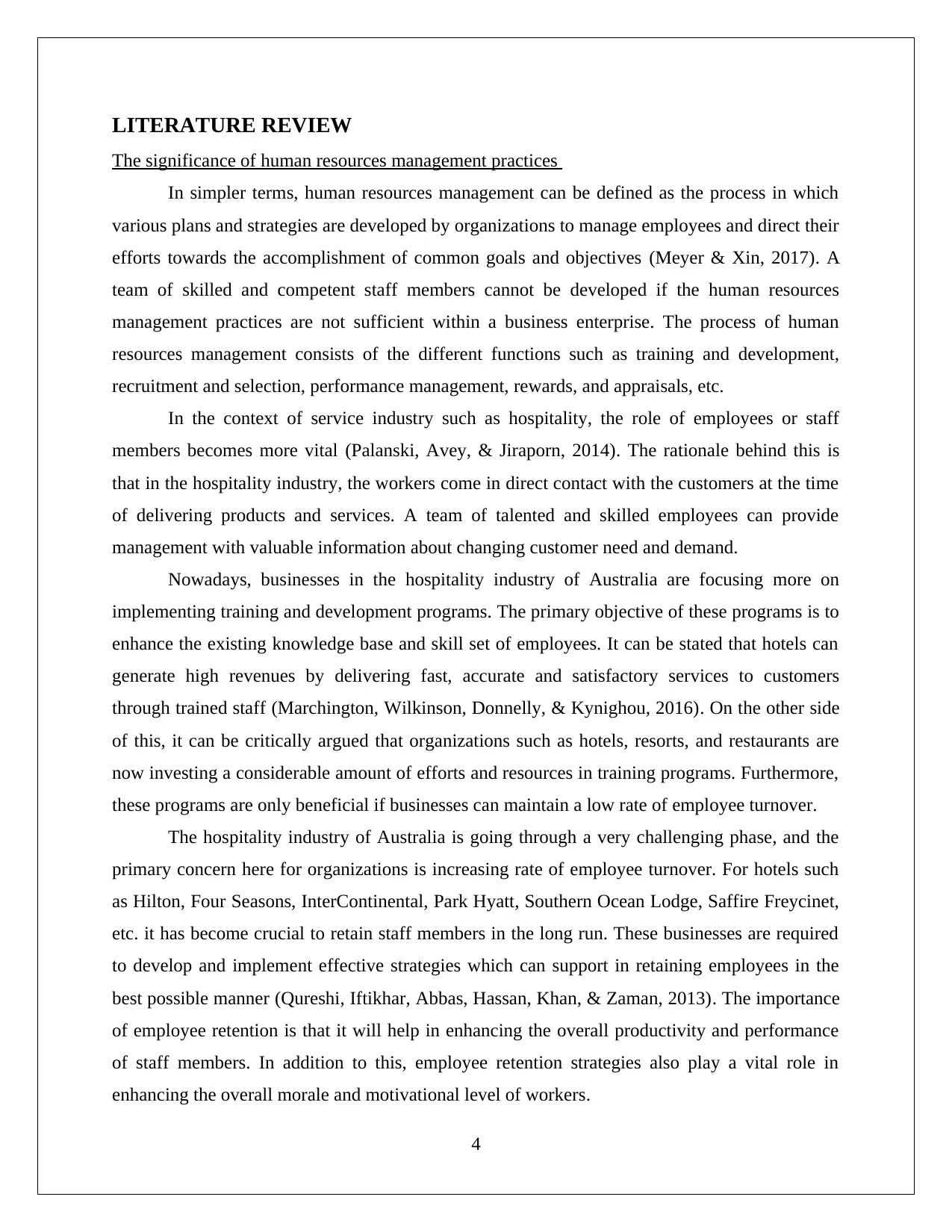
LITERATURE REVIEW
The significance of human resources management practices
In simpler terms, human resources management can be defined as the process in which
various plans and strategies are developed by organizations to manage employees and direct their
efforts towards the accomplishment of common goals and objectives (Meyer & Xin, 2017). A
team of skilled and competent staff members cannot be developed if the human resources
management practices are not sufficient within a business enterprise. The process of human
resources management consists of the different functions such as training and development,
recruitment and selection, performance management, rewards, and appraisals, etc.
In the context of service industry such as hospitality, the role of employees or staff
members becomes more vital (Palanski, Avey, & Jiraporn, 2014). The rationale behind this is
that in the hospitality industry, the workers come in direct contact with the customers at the time
of delivering products and services. A team of talented and skilled employees can provide
management with valuable information about changing customer need and demand.
Nowadays, businesses in the hospitality industry of Australia are focusing more on
implementing training and development programs. The primary objective of these programs is to
enhance the existing knowledge base and skill set of employees. It can be stated that hotels can
generate high revenues by delivering fast, accurate and satisfactory services to customers
through trained staff (Marchington, Wilkinson, Donnelly, & Kynighou, 2016). On the other side
of this, it can be critically argued that organizations such as hotels, resorts, and restaurants are
now investing a considerable amount of efforts and resources in training programs. Furthermore,
these programs are only beneficial if businesses can maintain a low rate of employee turnover.
The hospitality industry of Australia is going through a very challenging phase, and the
primary concern here for organizations is increasing rate of employee turnover. For hotels such
as Hilton, Four Seasons, InterContinental, Park Hyatt, Southern Ocean Lodge, Saffire Freycinet,
etc. it has become crucial to retain staff members in the long run. These businesses are required
to develop and implement effective strategies which can support in retaining employees in the
best possible manner (Qureshi, Iftikhar, Abbas, Hassan, Khan, & Zaman, 2013). The importance
of employee retention is that it will help in enhancing the overall productivity and performance
of staff members. In addition to this, employee retention strategies also play a vital role in
enhancing the overall morale and motivational level of workers.
4
The significance of human resources management practices
In simpler terms, human resources management can be defined as the process in which
various plans and strategies are developed by organizations to manage employees and direct their
efforts towards the accomplishment of common goals and objectives (Meyer & Xin, 2017). A
team of skilled and competent staff members cannot be developed if the human resources
management practices are not sufficient within a business enterprise. The process of human
resources management consists of the different functions such as training and development,
recruitment and selection, performance management, rewards, and appraisals, etc.
In the context of service industry such as hospitality, the role of employees or staff
members becomes more vital (Palanski, Avey, & Jiraporn, 2014). The rationale behind this is
that in the hospitality industry, the workers come in direct contact with the customers at the time
of delivering products and services. A team of talented and skilled employees can provide
management with valuable information about changing customer need and demand.
Nowadays, businesses in the hospitality industry of Australia are focusing more on
implementing training and development programs. The primary objective of these programs is to
enhance the existing knowledge base and skill set of employees. It can be stated that hotels can
generate high revenues by delivering fast, accurate and satisfactory services to customers
through trained staff (Marchington, Wilkinson, Donnelly, & Kynighou, 2016). On the other side
of this, it can be critically argued that organizations such as hotels, resorts, and restaurants are
now investing a considerable amount of efforts and resources in training programs. Furthermore,
these programs are only beneficial if businesses can maintain a low rate of employee turnover.
The hospitality industry of Australia is going through a very challenging phase, and the
primary concern here for organizations is increasing rate of employee turnover. For hotels such
as Hilton, Four Seasons, InterContinental, Park Hyatt, Southern Ocean Lodge, Saffire Freycinet,
etc. it has become crucial to retain staff members in the long run. These businesses are required
to develop and implement effective strategies which can support in retaining employees in the
best possible manner (Qureshi, Iftikhar, Abbas, Hassan, Khan, & Zaman, 2013). The importance
of employee retention is that it will help in enhancing the overall productivity and performance
of staff members. In addition to this, employee retention strategies also play a vital role in
enhancing the overall morale and motivational level of workers.
4
Paraphrase This Document
Need a fresh take? Get an instant paraphrase of this document with our AI Paraphraser
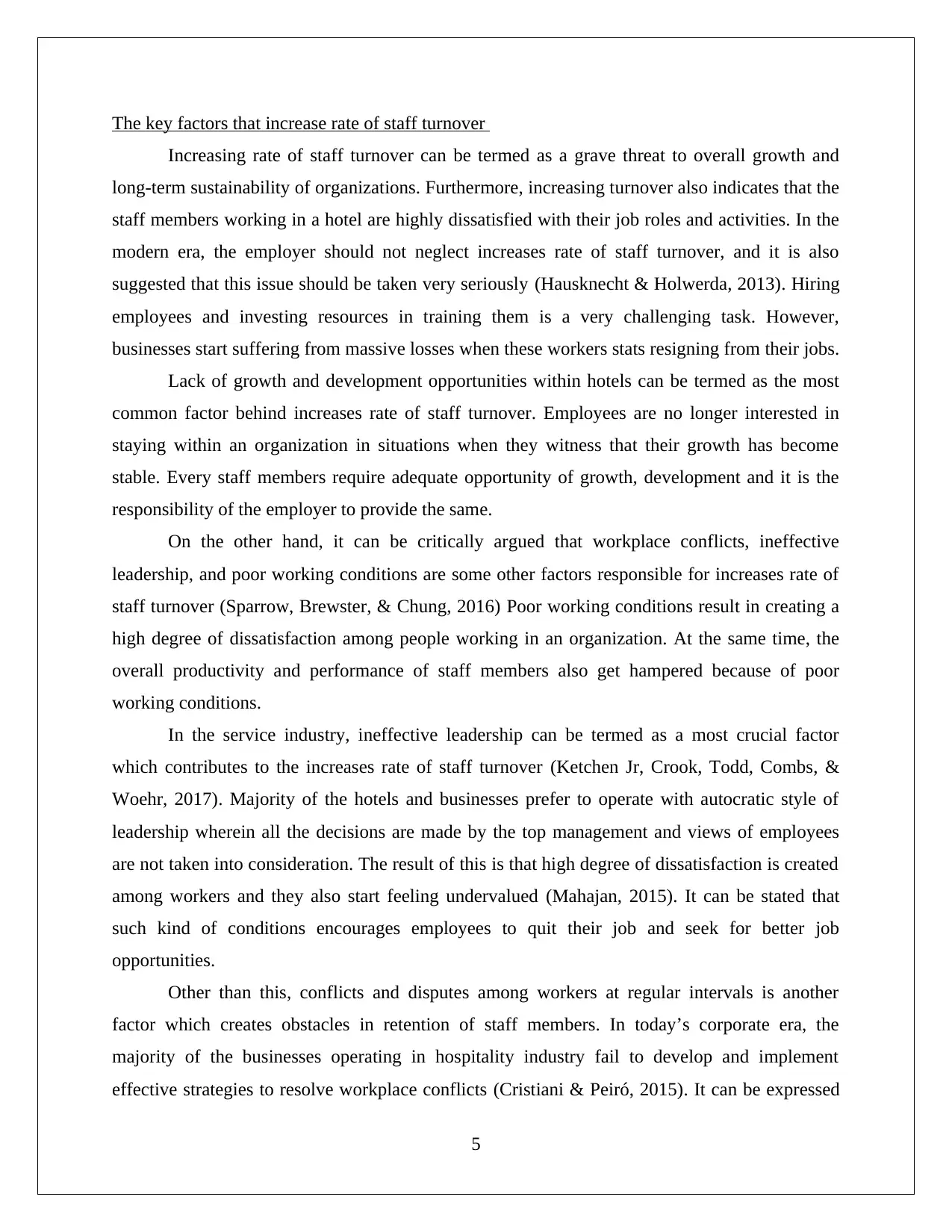
The key factors that increase rate of staff turnover
Increasing rate of staff turnover can be termed as a grave threat to overall growth and
long-term sustainability of organizations. Furthermore, increasing turnover also indicates that the
staff members working in a hotel are highly dissatisfied with their job roles and activities. In the
modern era, the employer should not neglect increases rate of staff turnover, and it is also
suggested that this issue should be taken very seriously (Hausknecht & Holwerda, 2013). Hiring
employees and investing resources in training them is a very challenging task. However,
businesses start suffering from massive losses when these workers stats resigning from their jobs.
Lack of growth and development opportunities within hotels can be termed as the most
common factor behind increases rate of staff turnover. Employees are no longer interested in
staying within an organization in situations when they witness that their growth has become
stable. Every staff members require adequate opportunity of growth, development and it is the
responsibility of the employer to provide the same.
On the other hand, it can be critically argued that workplace conflicts, ineffective
leadership, and poor working conditions are some other factors responsible for increases rate of
staff turnover (Sparrow, Brewster, & Chung, 2016) Poor working conditions result in creating a
high degree of dissatisfaction among people working in an organization. At the same time, the
overall productivity and performance of staff members also get hampered because of poor
working conditions.
In the service industry, ineffective leadership can be termed as a most crucial factor
which contributes to the increases rate of staff turnover (Ketchen Jr, Crook, Todd, Combs, &
Woehr, 2017). Majority of the hotels and businesses prefer to operate with autocratic style of
leadership wherein all the decisions are made by the top management and views of employees
are not taken into consideration. The result of this is that high degree of dissatisfaction is created
among workers and they also start feeling undervalued (Mahajan, 2015). It can be stated that
such kind of conditions encourages employees to quit their job and seek for better job
opportunities.
Other than this, conflicts and disputes among workers at regular intervals is another
factor which creates obstacles in retention of staff members. In today’s corporate era, the
majority of the businesses operating in hospitality industry fail to develop and implement
effective strategies to resolve workplace conflicts (Cristiani & Peiró, 2015). It can be expressed
5
Increasing rate of staff turnover can be termed as a grave threat to overall growth and
long-term sustainability of organizations. Furthermore, increasing turnover also indicates that the
staff members working in a hotel are highly dissatisfied with their job roles and activities. In the
modern era, the employer should not neglect increases rate of staff turnover, and it is also
suggested that this issue should be taken very seriously (Hausknecht & Holwerda, 2013). Hiring
employees and investing resources in training them is a very challenging task. However,
businesses start suffering from massive losses when these workers stats resigning from their jobs.
Lack of growth and development opportunities within hotels can be termed as the most
common factor behind increases rate of staff turnover. Employees are no longer interested in
staying within an organization in situations when they witness that their growth has become
stable. Every staff members require adequate opportunity of growth, development and it is the
responsibility of the employer to provide the same.
On the other hand, it can be critically argued that workplace conflicts, ineffective
leadership, and poor working conditions are some other factors responsible for increases rate of
staff turnover (Sparrow, Brewster, & Chung, 2016) Poor working conditions result in creating a
high degree of dissatisfaction among people working in an organization. At the same time, the
overall productivity and performance of staff members also get hampered because of poor
working conditions.
In the service industry, ineffective leadership can be termed as a most crucial factor
which contributes to the increases rate of staff turnover (Ketchen Jr, Crook, Todd, Combs, &
Woehr, 2017). Majority of the hotels and businesses prefer to operate with autocratic style of
leadership wherein all the decisions are made by the top management and views of employees
are not taken into consideration. The result of this is that high degree of dissatisfaction is created
among workers and they also start feeling undervalued (Mahajan, 2015). It can be stated that
such kind of conditions encourages employees to quit their job and seek for better job
opportunities.
Other than this, conflicts and disputes among workers at regular intervals is another
factor which creates obstacles in retention of staff members. In today’s corporate era, the
majority of the businesses operating in hospitality industry fail to develop and implement
effective strategies to resolve workplace conflicts (Cristiani & Peiró, 2015). It can be expressed
5
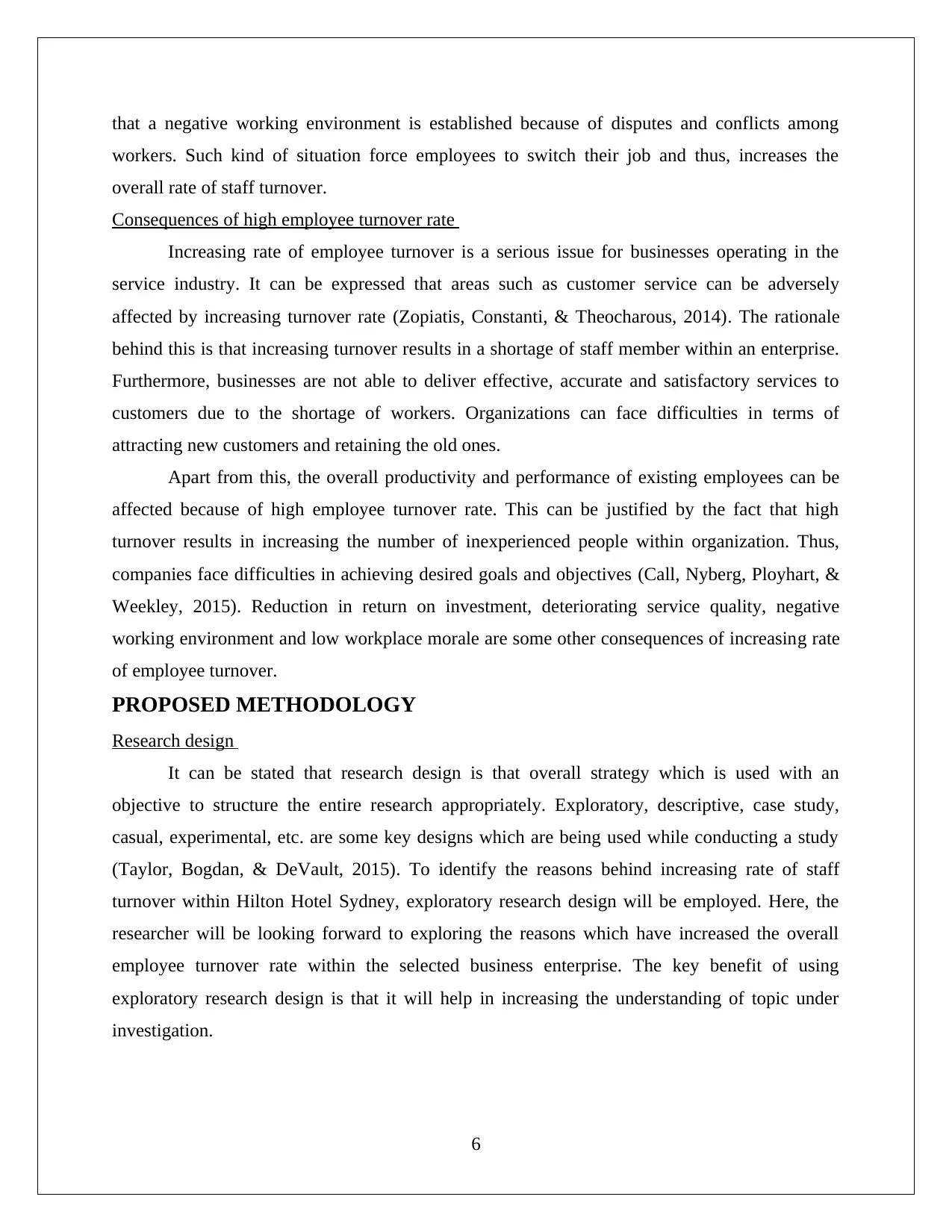
that a negative working environment is established because of disputes and conflicts among
workers. Such kind of situation force employees to switch their job and thus, increases the
overall rate of staff turnover.
Consequences of high employee turnover rate
Increasing rate of employee turnover is a serious issue for businesses operating in the
service industry. It can be expressed that areas such as customer service can be adversely
affected by increasing turnover rate (Zopiatis, Constanti, & Theocharous, 2014). The rationale
behind this is that increasing turnover results in a shortage of staff member within an enterprise.
Furthermore, businesses are not able to deliver effective, accurate and satisfactory services to
customers due to the shortage of workers. Organizations can face difficulties in terms of
attracting new customers and retaining the old ones.
Apart from this, the overall productivity and performance of existing employees can be
affected because of high employee turnover rate. This can be justified by the fact that high
turnover results in increasing the number of inexperienced people within organization. Thus,
companies face difficulties in achieving desired goals and objectives (Call, Nyberg, Ployhart, &
Weekley, 2015). Reduction in return on investment, deteriorating service quality, negative
working environment and low workplace morale are some other consequences of increasing rate
of employee turnover.
PROPOSED METHODOLOGY
Research design
It can be stated that research design is that overall strategy which is used with an
objective to structure the entire research appropriately. Exploratory, descriptive, case study,
casual, experimental, etc. are some key designs which are being used while conducting a study
(Taylor, Bogdan, & DeVault, 2015). To identify the reasons behind increasing rate of staff
turnover within Hilton Hotel Sydney, exploratory research design will be employed. Here, the
researcher will be looking forward to exploring the reasons which have increased the overall
employee turnover rate within the selected business enterprise. The key benefit of using
exploratory research design is that it will help in increasing the understanding of topic under
investigation.
6
workers. Such kind of situation force employees to switch their job and thus, increases the
overall rate of staff turnover.
Consequences of high employee turnover rate
Increasing rate of employee turnover is a serious issue for businesses operating in the
service industry. It can be expressed that areas such as customer service can be adversely
affected by increasing turnover rate (Zopiatis, Constanti, & Theocharous, 2014). The rationale
behind this is that increasing turnover results in a shortage of staff member within an enterprise.
Furthermore, businesses are not able to deliver effective, accurate and satisfactory services to
customers due to the shortage of workers. Organizations can face difficulties in terms of
attracting new customers and retaining the old ones.
Apart from this, the overall productivity and performance of existing employees can be
affected because of high employee turnover rate. This can be justified by the fact that high
turnover results in increasing the number of inexperienced people within organization. Thus,
companies face difficulties in achieving desired goals and objectives (Call, Nyberg, Ployhart, &
Weekley, 2015). Reduction in return on investment, deteriorating service quality, negative
working environment and low workplace morale are some other consequences of increasing rate
of employee turnover.
PROPOSED METHODOLOGY
Research design
It can be stated that research design is that overall strategy which is used with an
objective to structure the entire research appropriately. Exploratory, descriptive, case study,
casual, experimental, etc. are some key designs which are being used while conducting a study
(Taylor, Bogdan, & DeVault, 2015). To identify the reasons behind increasing rate of staff
turnover within Hilton Hotel Sydney, exploratory research design will be employed. Here, the
researcher will be looking forward to exploring the reasons which have increased the overall
employee turnover rate within the selected business enterprise. The key benefit of using
exploratory research design is that it will help in increasing the understanding of topic under
investigation.
6
⊘ This is a preview!⊘
Do you want full access?
Subscribe today to unlock all pages.

Trusted by 1+ million students worldwide
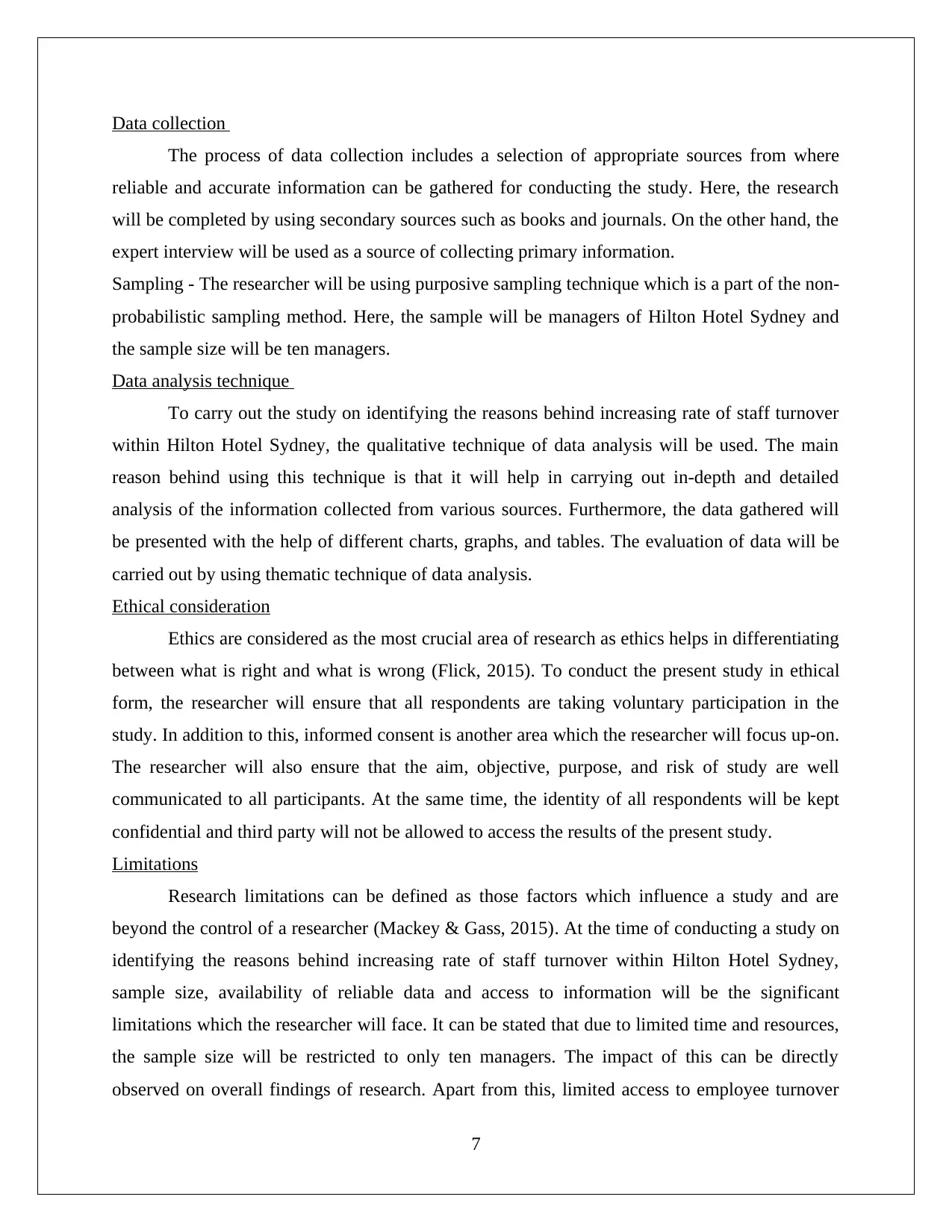
Data collection
The process of data collection includes a selection of appropriate sources from where
reliable and accurate information can be gathered for conducting the study. Here, the research
will be completed by using secondary sources such as books and journals. On the other hand, the
expert interview will be used as a source of collecting primary information.
Sampling - The researcher will be using purposive sampling technique which is a part of the non-
probabilistic sampling method. Here, the sample will be managers of Hilton Hotel Sydney and
the sample size will be ten managers.
Data analysis technique
To carry out the study on identifying the reasons behind increasing rate of staff turnover
within Hilton Hotel Sydney, the qualitative technique of data analysis will be used. The main
reason behind using this technique is that it will help in carrying out in-depth and detailed
analysis of the information collected from various sources. Furthermore, the data gathered will
be presented with the help of different charts, graphs, and tables. The evaluation of data will be
carried out by using thematic technique of data analysis.
Ethical consideration
Ethics are considered as the most crucial area of research as ethics helps in differentiating
between what is right and what is wrong (Flick, 2015). To conduct the present study in ethical
form, the researcher will ensure that all respondents are taking voluntary participation in the
study. In addition to this, informed consent is another area which the researcher will focus up-on.
The researcher will also ensure that the aim, objective, purpose, and risk of study are well
communicated to all participants. At the same time, the identity of all respondents will be kept
confidential and third party will not be allowed to access the results of the present study.
Limitations
Research limitations can be defined as those factors which influence a study and are
beyond the control of a researcher (Mackey & Gass, 2015). At the time of conducting a study on
identifying the reasons behind increasing rate of staff turnover within Hilton Hotel Sydney,
sample size, availability of reliable data and access to information will be the significant
limitations which the researcher will face. It can be stated that due to limited time and resources,
the sample size will be restricted to only ten managers. The impact of this can be directly
observed on overall findings of research. Apart from this, limited access to employee turnover
7
The process of data collection includes a selection of appropriate sources from where
reliable and accurate information can be gathered for conducting the study. Here, the research
will be completed by using secondary sources such as books and journals. On the other hand, the
expert interview will be used as a source of collecting primary information.
Sampling - The researcher will be using purposive sampling technique which is a part of the non-
probabilistic sampling method. Here, the sample will be managers of Hilton Hotel Sydney and
the sample size will be ten managers.
Data analysis technique
To carry out the study on identifying the reasons behind increasing rate of staff turnover
within Hilton Hotel Sydney, the qualitative technique of data analysis will be used. The main
reason behind using this technique is that it will help in carrying out in-depth and detailed
analysis of the information collected from various sources. Furthermore, the data gathered will
be presented with the help of different charts, graphs, and tables. The evaluation of data will be
carried out by using thematic technique of data analysis.
Ethical consideration
Ethics are considered as the most crucial area of research as ethics helps in differentiating
between what is right and what is wrong (Flick, 2015). To conduct the present study in ethical
form, the researcher will ensure that all respondents are taking voluntary participation in the
study. In addition to this, informed consent is another area which the researcher will focus up-on.
The researcher will also ensure that the aim, objective, purpose, and risk of study are well
communicated to all participants. At the same time, the identity of all respondents will be kept
confidential and third party will not be allowed to access the results of the present study.
Limitations
Research limitations can be defined as those factors which influence a study and are
beyond the control of a researcher (Mackey & Gass, 2015). At the time of conducting a study on
identifying the reasons behind increasing rate of staff turnover within Hilton Hotel Sydney,
sample size, availability of reliable data and access to information will be the significant
limitations which the researcher will face. It can be stated that due to limited time and resources,
the sample size will be restricted to only ten managers. The impact of this can be directly
observed on overall findings of research. Apart from this, limited access to employee turnover
7
Paraphrase This Document
Need a fresh take? Get an instant paraphrase of this document with our AI Paraphraser
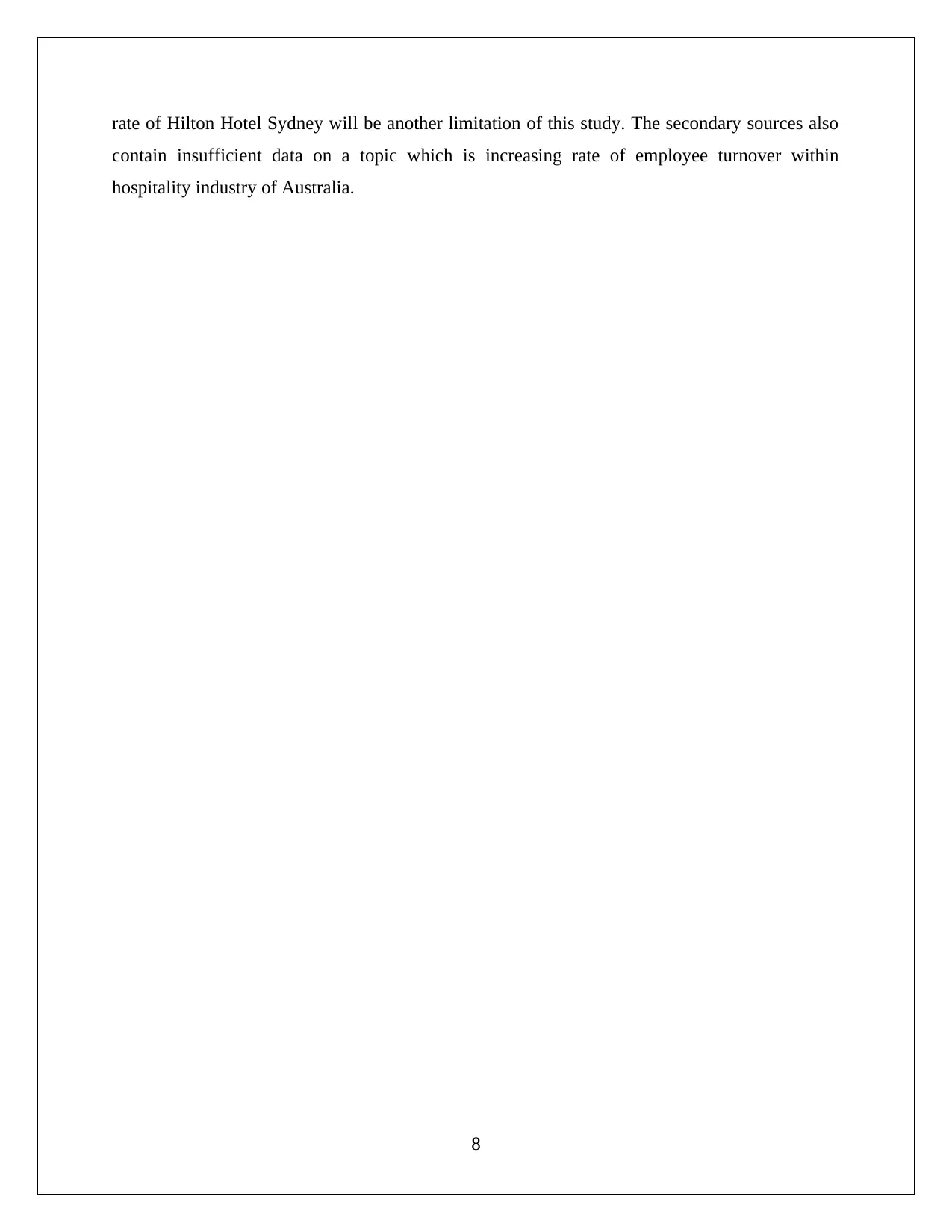
rate of Hilton Hotel Sydney will be another limitation of this study. The secondary sources also
contain insufficient data on a topic which is increasing rate of employee turnover within
hospitality industry of Australia.
8
contain insufficient data on a topic which is increasing rate of employee turnover within
hospitality industry of Australia.
8
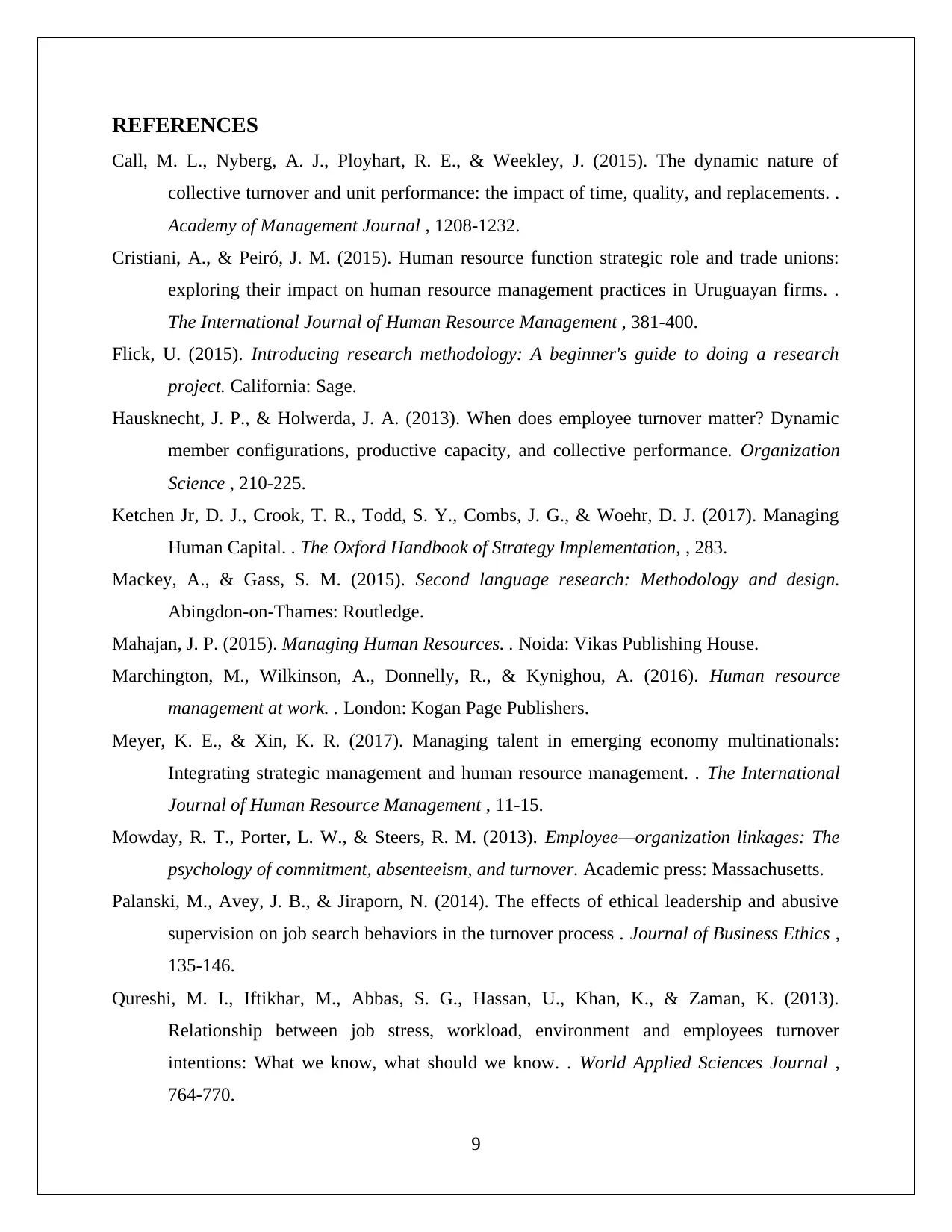
REFERENCES
Call, M. L., Nyberg, A. J., Ployhart, R. E., & Weekley, J. (2015). The dynamic nature of
collective turnover and unit performance: the impact of time, quality, and replacements. .
Academy of Management Journal , 1208-1232.
Cristiani, A., & Peiró, J. M. (2015). Human resource function strategic role and trade unions:
exploring their impact on human resource management practices in Uruguayan firms. .
The International Journal of Human Resource Management , 381-400.
Flick, U. (2015). Introducing research methodology: A beginner's guide to doing a research
project. California: Sage.
Hausknecht, J. P., & Holwerda, J. A. (2013). When does employee turnover matter? Dynamic
member configurations, productive capacity, and collective performance. Organization
Science , 210-225.
Ketchen Jr, D. J., Crook, T. R., Todd, S. Y., Combs, J. G., & Woehr, D. J. (2017). Managing
Human Capital. . The Oxford Handbook of Strategy Implementation, , 283.
Mackey, A., & Gass, S. M. (2015). Second language research: Methodology and design.
Abingdon-on-Thames: Routledge.
Mahajan, J. P. (2015). Managing Human Resources. . Noida: Vikas Publishing House.
Marchington, M., Wilkinson, A., Donnelly, R., & Kynighou, A. (2016). Human resource
management at work. . London: Kogan Page Publishers.
Meyer, K. E., & Xin, K. R. (2017). Managing talent in emerging economy multinationals:
Integrating strategic management and human resource management. . The International
Journal of Human Resource Management , 11-15.
Mowday, R. T., Porter, L. W., & Steers, R. M. (2013). Employee—organization linkages: The
psychology of commitment, absenteeism, and turnover. Academic press: Massachusetts.
Palanski, M., Avey, J. B., & Jiraporn, N. (2014). The effects of ethical leadership and abusive
supervision on job search behaviors in the turnover process . Journal of Business Ethics ,
135-146.
Qureshi, M. I., Iftikhar, M., Abbas, S. G., Hassan, U., Khan, K., & Zaman, K. (2013).
Relationship between job stress, workload, environment and employees turnover
intentions: What we know, what should we know. . World Applied Sciences Journal ,
764-770.
9
Call, M. L., Nyberg, A. J., Ployhart, R. E., & Weekley, J. (2015). The dynamic nature of
collective turnover and unit performance: the impact of time, quality, and replacements. .
Academy of Management Journal , 1208-1232.
Cristiani, A., & Peiró, J. M. (2015). Human resource function strategic role and trade unions:
exploring their impact on human resource management practices in Uruguayan firms. .
The International Journal of Human Resource Management , 381-400.
Flick, U. (2015). Introducing research methodology: A beginner's guide to doing a research
project. California: Sage.
Hausknecht, J. P., & Holwerda, J. A. (2013). When does employee turnover matter? Dynamic
member configurations, productive capacity, and collective performance. Organization
Science , 210-225.
Ketchen Jr, D. J., Crook, T. R., Todd, S. Y., Combs, J. G., & Woehr, D. J. (2017). Managing
Human Capital. . The Oxford Handbook of Strategy Implementation, , 283.
Mackey, A., & Gass, S. M. (2015). Second language research: Methodology and design.
Abingdon-on-Thames: Routledge.
Mahajan, J. P. (2015). Managing Human Resources. . Noida: Vikas Publishing House.
Marchington, M., Wilkinson, A., Donnelly, R., & Kynighou, A. (2016). Human resource
management at work. . London: Kogan Page Publishers.
Meyer, K. E., & Xin, K. R. (2017). Managing talent in emerging economy multinationals:
Integrating strategic management and human resource management. . The International
Journal of Human Resource Management , 11-15.
Mowday, R. T., Porter, L. W., & Steers, R. M. (2013). Employee—organization linkages: The
psychology of commitment, absenteeism, and turnover. Academic press: Massachusetts.
Palanski, M., Avey, J. B., & Jiraporn, N. (2014). The effects of ethical leadership and abusive
supervision on job search behaviors in the turnover process . Journal of Business Ethics ,
135-146.
Qureshi, M. I., Iftikhar, M., Abbas, S. G., Hassan, U., Khan, K., & Zaman, K. (2013).
Relationship between job stress, workload, environment and employees turnover
intentions: What we know, what should we know. . World Applied Sciences Journal ,
764-770.
9
⊘ This is a preview!⊘
Do you want full access?
Subscribe today to unlock all pages.

Trusted by 1+ million students worldwide
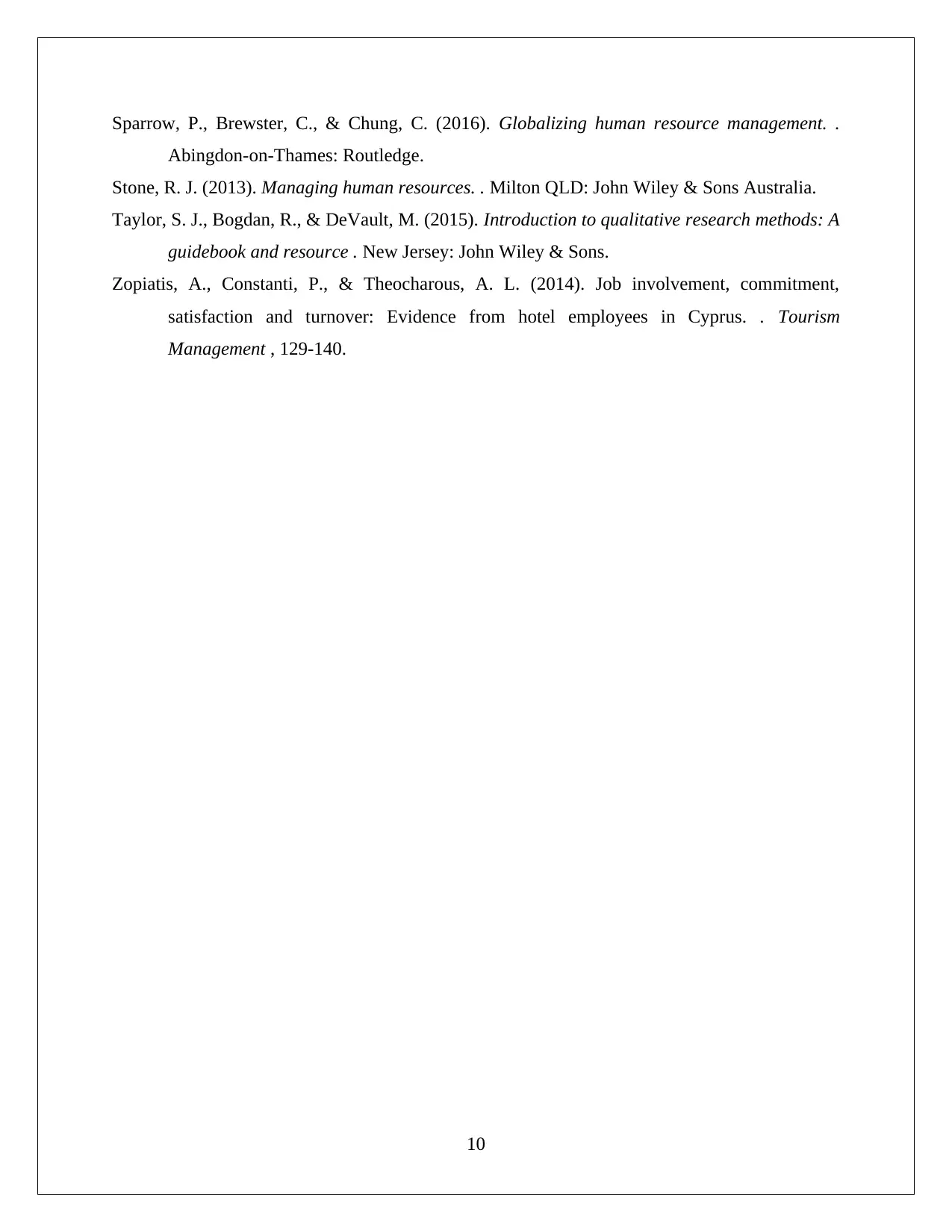
Sparrow, P., Brewster, C., & Chung, C. (2016). Globalizing human resource management. .
Abingdon-on-Thames: Routledge.
Stone, R. J. (2013). Managing human resources. . Milton QLD: John Wiley & Sons Australia.
Taylor, S. J., Bogdan, R., & DeVault, M. (2015). Introduction to qualitative research methods: A
guidebook and resource . New Jersey: John Wiley & Sons.
Zopiatis, A., Constanti, P., & Theocharous, A. L. (2014). Job involvement, commitment,
satisfaction and turnover: Evidence from hotel employees in Cyprus. . Tourism
Management , 129-140.
10
Abingdon-on-Thames: Routledge.
Stone, R. J. (2013). Managing human resources. . Milton QLD: John Wiley & Sons Australia.
Taylor, S. J., Bogdan, R., & DeVault, M. (2015). Introduction to qualitative research methods: A
guidebook and resource . New Jersey: John Wiley & Sons.
Zopiatis, A., Constanti, P., & Theocharous, A. L. (2014). Job involvement, commitment,
satisfaction and turnover: Evidence from hotel employees in Cyprus. . Tourism
Management , 129-140.
10
1 out of 10
Related Documents
Your All-in-One AI-Powered Toolkit for Academic Success.
+13062052269
info@desklib.com
Available 24*7 on WhatsApp / Email
![[object Object]](/_next/static/media/star-bottom.7253800d.svg)
Unlock your academic potential
Copyright © 2020–2025 A2Z Services. All Rights Reserved. Developed and managed by ZUCOL.





